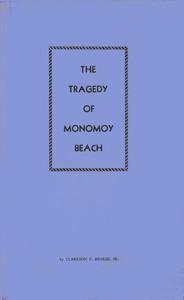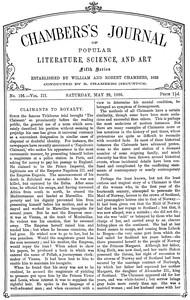|
|
Read this ebook for free! No credit card needed, absolutely nothing to pay.Words: 24513 in 3 pages
This is an ebook sharing website. You can read the uploaded ebooks for free here. No credit cards needed, nothing to pay. If you want to own a digital copy of the ebook, or want to read offline with your favorite ebook-reader, then you can choose to buy and download the ebook.

: The tragedy of Monomoy Beach by Bearse Clarkson P - Lifesaving stations Cape Cod; Monomoy Island (Mass.) History; Monomoy Life-Saving Station (U.S.); Shipwrecks Cape Cod@FreeBooksThu 08 Jun, 2023 Produced by: Steve Mattern THE TRAGEDY of MONOMOY BEACH THE GRAVEYARD OF THE ATLANTIC by CLARKSON P. BEARSE, SR. Designed, printed and published on Cape Cod by THE GOSS PRINT HARWICH, MASSACHUSETTS This will introduce to our readers, the author, Clarkson P. Bearse, Sr. He is a native Cape Codder and lives in a peaceful typical Cape Cod home in Harwich Port. In fact he is Postmaster of the Harwich Port Post office. He was a former member of the Coast Guard Station which figured in the Monomoy disaster. Due to an injury received in the line of duty he was unable to report for service, or otherwise he would have been another victim rather than the author of this thrilling story of the sea. For many years he retained the facts about this world famous tragedy, second only in importance to the Portland disaster. His modesty caused him to refrain from telling the story until his friends finally prevailed upon him to fill in at a Grange lecture hour one night. Then Kiwanis listened to him and was thrilled. Then other organizations sought his thrilling story. We know he will thrill you, too, as he paints his vivid word picture. No living person can tell this story like Mr. Bearse. This tragedy of the sea is only one of hundreds of ship wrecks which have made these shoals known as "The Graveyard of the Atlantic" all over the world. We are proud to present this copyrighted edition for your reading pleasure. THE TRAGEDY of MONOMOY BEACH or THE GRAVEYARD of THE ATLANTIC I was born and brought up on Cape Cod. To me it is the only place on earth. In olden times, in times gone by, people away from here had the idea that Cape Cod was a narrow strip of land extending off into the ocean, consisting of sand dunes and fish shanties. But in recent years there has been a radical change in the opinion people have had about Cape Cod. Now they are looking at Cape Cod as it really is. The automobile, the chamber of commerce, boards of trade, and other advertising agencies have opened Cape Cod wide, and it has been explored from one end to the other by thousands and thousands. Now some of these people are prophesying the future of Cape Cod, but they are not only prophesying the future of Cape Cod but they are delving down into the past--down into its past records and past history. Recently, almost within the year, they have gone down forty-one years and have come up with the old Monomoy Disaster. Sometimes they come into the post-office and question me about the disaster. I not only have to admit that I had been associated with those men who were lost, but was familiar with the disaster itself, so I have been telling them and all others who were interested by an address. I appreciate the privilege of addressing so many distinguished gatherings. It was the seventeenth day of March 1902, when the news spread--and it spread like wildfire all over--not only over the towns of Chatham and Harwich, the two towns most directly affected by the disaster, but over the surrounding towns and all over Cape Cod, for that matter. Women ran from one house to the other, telling the news--men congregated on corners, in stores and elsewhere, discussing the news. The report was that every surfman on the old Monomoy Lifesaving Station, with the exception of one, had been lost. They had perished off the back side of Monomoy Beach in the tide rips and the seas. In telling the story, I have entitled it, "The Tragedy of Monomoy Beach or the Graveyard of the Atlantic." Eight miles down from Harwich is the town of Chatham. Everybody knows that Monomoy Beach extends off from Chatham--off into Nantucket Sound in a southerly direction something like ten miles. It is approximately two miles wide, and is composed wholly of beach sand, a growth of beach grass, occasionally a brush swamp, and a few meadows. Its topographic makeup is sand dunes and hollows, hollows and sand dunes, all sizes and shapes, and the sand continues to blow and shift. Today there is a sand dune, tonight a dry gale of wind, tomorrow a piece of level ground. Today there is a piece of level ground, tonight a sand storm, tomorrow a hollow. So it is, year in and year out. The sand continues to blow and shift. Free books android app tbrJar TBR JAR Read Free books online gutenberg More posts by @FreeBooks
: Chambers's Journal of Popular Literature Science and Art fifth series no. 126 vol. III May 29 1886 by Various - Periodicals@FreeBooksThu 08 Jun, 2023

: Little soldiers all by Stooke Eleanora H - Christian life Juvenile fiction; Families Juvenile fiction; World War 1914-1918 England Juvenile fiction@FreeBooksThu 08 Jun, 2023
|
Terms of Use Stock Market News! © gutenberg.org.in2025 All Rights reserved.






